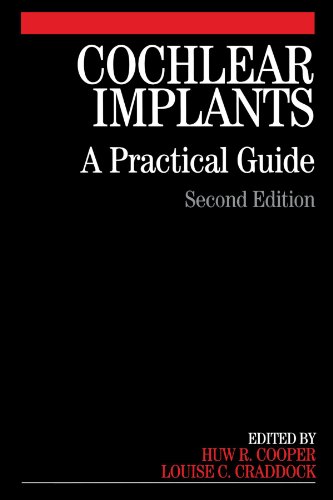Cochlear Implants A Practical Guide 2nd Edition by Huw R Cooper ISBN 1861564813 9781861564818 by Huw Cooper, Louise Craddock 1861564813, 9781861564818 instant download after payment.
Cochlear Implants A Practical Guide 1st Edition by Huw R Cooper - Ebook PDF Instant Download/Delivery: 1861564813, 9781861564818
Full download Cochlear Implants A Practical Guide 1st Edition after payment

Product details:
ISBN 10: 1861564813
ISBN 13: 9781861564818
Author: Huw R Cooper
Cochlear Implants A Practical Guide 1st Table of contents:
Part I: Understanding Hearing Loss and Cochlear Implants
Chapter 1: The Basics of Hearing and Hearing Loss
- 1.1 How We Hear: Anatomy and Physiology of the Ear
- 1.2 Types of Hearing Loss: Conductive, Sensorineural, Mixed
- 1.3 Degrees of Hearing Loss: Mild to Profound
- 1.4 Impact of Hearing Loss: Communication, Social, and Developmental Aspects
- 1.5 Introduction to Hearing Aids and Their Limitations
Chapter 2: What is a Cochlear Implant?
- 2.1 The Components of a Cochlear Implant System (External Processor, Internal Implant)
- 2.2 How a Cochlear Implant Works: Sound Processing and Electrical Stimulation
- 2.3 Cochlear Implants vs. Hearing Aids: Key Differences
- 2.4 History and Evolution of Cochlear Implant Technology
- 2.5 Overview of Different Cochlear Implant Manufacturers and Models
Part II: The Candidacy Process
Chapter 3: Who is a Candidate for a Cochlear Implant?
- 3.1 Audiological Criteria for Adults and Children
- 3.2 Medical and Surgical Considerations
- 3.3 Psychosocial Factors and Realistic Expectations
- 3.4 Unilateral vs. Bilateral Implantation: Decision-Making
- 3.5 Specific Considerations for Special Populations (e.g., Auditory Neuropathy, Single-Sided Deafness)
Chapter 4: The Candidacy Evaluation Team and Process
- 4.1 The Multidisciplinary Team: Audiologist, ENT Surgeon, Speech-Language Pathologist, Psychologist, Educator
- 4.2 Comprehensive Audiological Evaluation
- 4.3 Medical Workup: Imaging (CT/MRI) and Other Assessments
- 4.4 Speech and Language Assessments
- 4.5 Psychological and Social Assessments
- 4.6 Counseling and Informed Consent
Part III: Surgery and Initial Activation
Chapter 5: The Cochlear Implant Surgery
- 5.1 Pre-Operative Preparation
- 5.2 Understanding the Surgical Procedure
- 5.3 Potential Risks and Complications
- 5.4 Post-Operative Care and Recovery
- 5.5 What to Expect Immediately After Surgery
Chapter 6: Initial Activation and Mapping (The "Switch-On")
- 6.1 The Healing Period and When Activation Occurs
- 6.2 The First Mapping Session: What Happens
- 6.3 Understanding Your Child's/Your Map
- 6.4 Initial Sound Perceptions and Expectations
- 6.5 Setting Up Home Listening Environments
Part IV: Rehabilitation and Living with a Cochlear Implant
Chapter 7: Auditory Rehabilitation for Children
- 7.1 Importance of Early Intervention
- 7.2 Auditory-Verbal Therapy (AVT) and Other Approaches
- 7.3 Developing Listening and Spoken Language Skills
- 7.4 Integrating CI Use into Daily Life and Play
- 7.5 The Role of Parents, Educators, and Therapists
Chapter 8: Auditory Rehabilitation for Adults
- 8.1 Adapting to New Sound Sensations
- 8.2 Auditory Training Programs and Strategies
- 8.3 Improving Speech Understanding in Noise
- 8.4 Using Communication Strategies and Resources
- 8.5 Managing Expectations and Realistic Outcomes
Chapter 9: Daily Management and Troubleshooting
- 9.1 Caring for the External Processor: Cleaning, Drying, Storage
- 9.2 Battery Management and Power Sources
- 9.3 Basic Troubleshooting: Common Issues and Solutions
- 9.4 When to Contact Your Audiologist or Manufacturer
- 9.5 Protecting the Internal Implant
Chapter 10: Advanced Features and Accessories
- 10.1 Understanding Different Programs/Maps for Various Environments
- 10.2 Connectivity Options: Bluetooth, Telecoil, FM Systems, Remote Microphones
- 10.3 Waterproofing Accessories for Active Lifestyles
- 10.4 Remote Controls and Smartphone Apps
- 10.5 Future Trends in CI Technology
Chapter 11: Long-Term Management and Follow-Up
- 11.1 Regular Mapping and Audiological Assessments
- 11.2 Monitoring Speech and Language Development (for children)
- 11.3 Managing Device Upgrades and Replacements
- 11.4 Addressing Performance Changes and Concerns
- 11.5 Maintaining a Relationship with Your CI Team
Part V: Social, Educational, and Lifestyle Aspects
Chapter 12: Cochlear Implants in Educational Settings
- 12.1 Choosing the Right Educational Placement
- 12.2 Working with Teachers and School Staff
- 12.3 Classroom Acoustics and Assistive Listening Devices
- 12.4 Supporting Social-Emotional Development
- 12.5 Advocacy and Legal Rights
Chapter 13: Communication Strategies and Social Integration
- 13.1 Effective Communication in Various Settings
- 13.2 Navigating Social Situations and Group Conversations
- 13.3 Explaining Your CI to Others
- 13.4 Building Confidence and Self-Advocacy
- 13.5 The Role of Family and Friends
Chapter 14: Sports, Travel, and Special Considerations
- 14.1 Participating in Sports and Physical Activities
- 14.2 Traveling with a Cochlear Implant (Airport Security, Medical Records)
- 14.3 Safety in Specific Environments (e.g., MRI, X-rays)
- 14.4 Emergency Preparedness
- 14.5 The Impact of Cochlear Implants on Quality of Life
Chapter 15: Cochlear Implants and the Deaf Community
- 15.1 Exploring Different Perspectives on Cochlear Implants
- 15.2 The Role of American Sign Language (ASL) and Biculturalism
- 15.3 Respecting Diversity within the Deaf and Hard of Hearing Communities
- 15.4 Bridging Gaps and Promoting Understanding
Conclusion: A Journey of Sound and Connection
- 16.1 Key Takeaways and Empowerment
- 16.2 Continuous Learning and Adaptation
- 16.3 The Evolving Landscape of Hearing Technology
- 16.4 Hope and Optimism for Future Generations
People also search for Cochlear Implants A Practical Guide 1st:
cochlear implants: a practical guide
cochlear implants a practical guide
how long do cochlear implants last
cochlear implant safety guidelines
cochlear implant practice
Tags: Huw R Cooper, Cochlear, Implants



